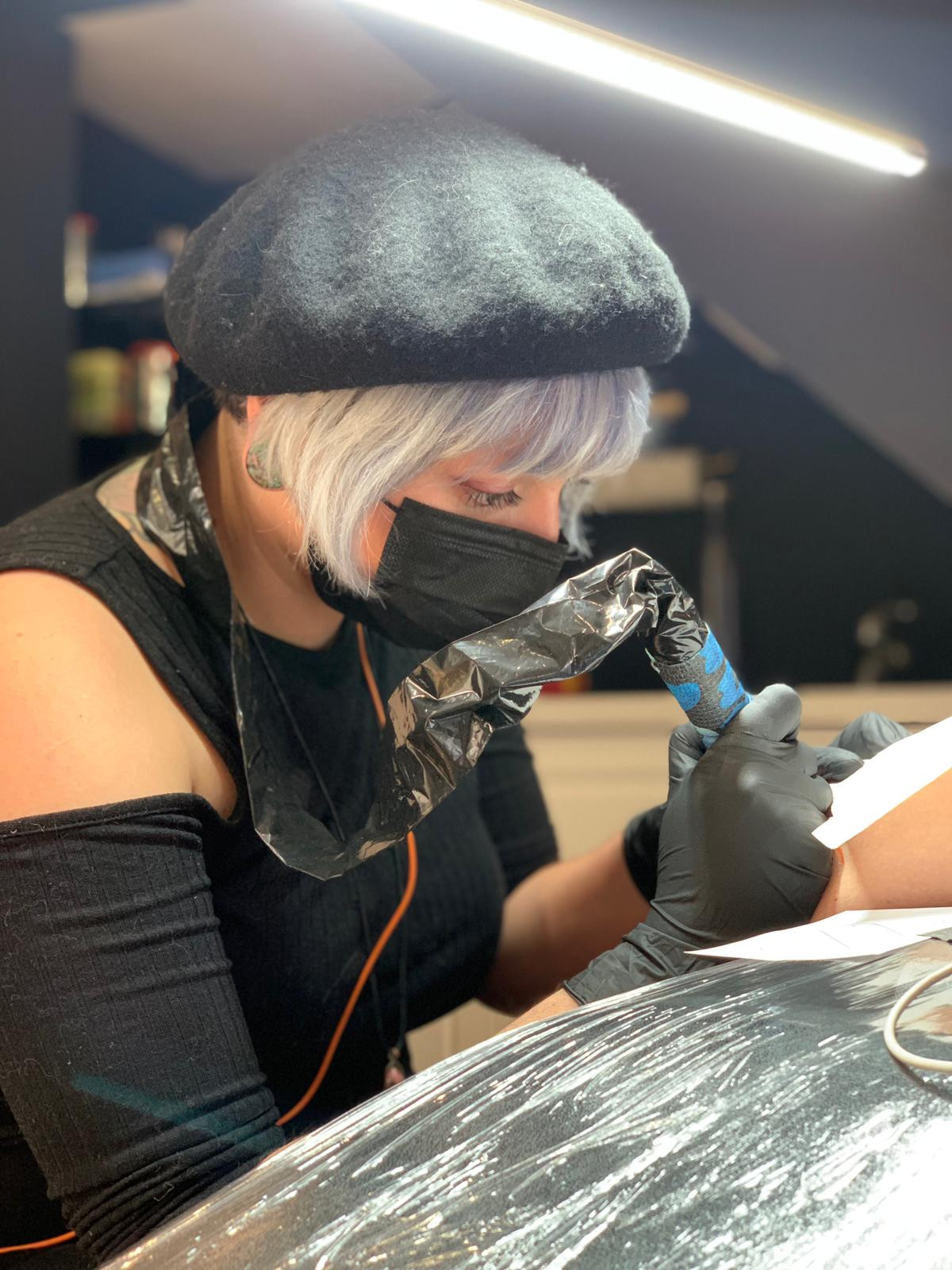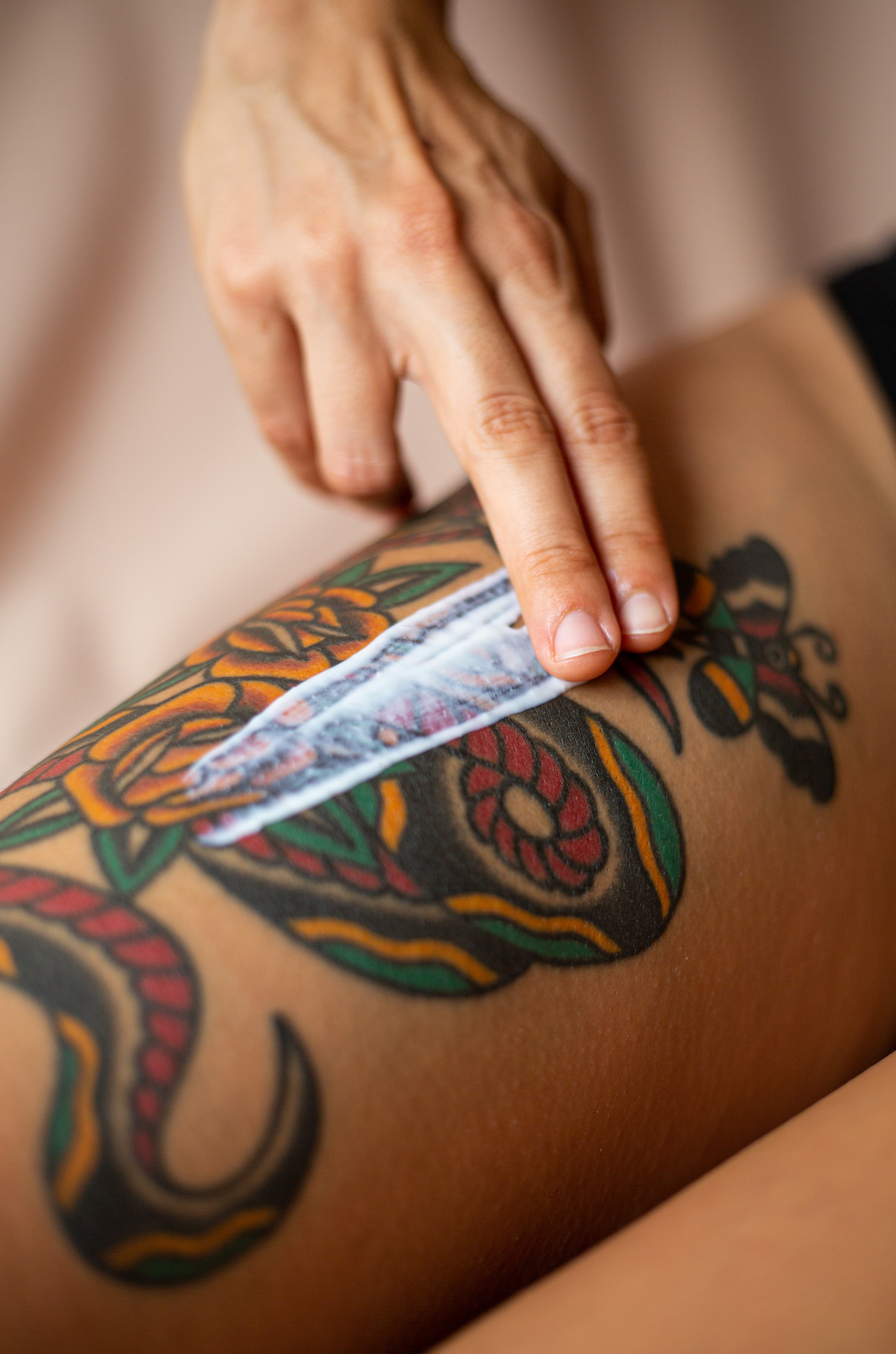Micro tattoos, a delicate and minimalist form of body art, have surged in popularity, but How Do Micro Tattoos Age? At tattooat.com, we understand your concerns about the longevity and appearance of these intricate designs. This guide delves into the factors influencing tattoo aging, providing insights on how to keep your micro tattoo looking its best. Discover expert advice and aftercare tips to preserve your cherished ink for years to come and explore a variety of stunning tattoo designs.
1. What Happens to Your Skin When You Get a Tattoo?
When a tattoo needle pierces the skin, it initiates a cascade of events at the microscopic level. Initially, this process causes local inflammation, tissue swelling, and rupture of superficial capillaries in the dermis, leading to minor bleeding. During the healing phase, exudate plugs form, temporarily sealing the skin perforations created by the needles. The superficial layers of the epidermis gradually peel off over the following weeks, eliminating pigment particles that remain too high in the epidermis. Therefore, only tattoo pigments that persist in the dermis contribute to the final, lasting appearance of the tattoo, giving it a matte finish once the epidermis has fully regenerated. Macrophages progressively engulf the pigments through phagocytosis, transporting them to local drainage nodes, while the remaining pigment primarily resides within fibroblasts and macrophages that did not migrate. Furthermore, some pigments can be found within the connective tissue of the dermis, nestled between collagen bundles.
 Close-up of tattoo needle piercing skin, emphasizing the microscopic interaction between ink and skin cells
Close-up of tattoo needle piercing skin, emphasizing the microscopic interaction between ink and skin cells
The tattoo does not remain histologically inert throughout its lifespan. Macrophagic activation, subtle inflammatory changes (including mild fibrosis of the papillary dermis, capillary proliferation, and non-specific lymphocytic infiltration), can be observed.
2. Why Do Tattoos Fade as Skin Ages?
Tattoo fading is inevitable, with skin aging influenced by several factors. Chronological aging is unavoidable, although genetic diversity causes variations in the signs of aging at any given age. Hormonal changes, such as menopause in women, also play a role. Photoaging affects sun-exposed areas like the face, neck, and hands, differing based on location and skin fairness. Additionally, smoking contributes to skin aging.
Normal skin aging involves loss of laxity, increased pallor, dryness, fragility (leading to easy bruising and skin tears), irregular pigmentation, and hair loss.
Tattoo fading arises from light-induced decomposition in tattooed skin or pigment transportation via the lymphatic system. Pigment migration via macrophages may cause blurry lines.
Tattoo color fading/bleaching is akin to colors fading on textiles or book covers after sun exposure. However, changes in tattoo color concentration may be overlooked due to the high color strength of azo pigments.
3. How Does Collagen Affect Tattoo Aging?
Collagen plays a crucial role in the skin’s structure and resilience. As skin ages, a reduction in collagen density and thinning of the dermis occurs, which is linked to a decrease in all its components: collagen and elastic fibers, glycosaminoglycans of the extracellular matrix, especially hyaluronic acid. This leads to an overall reduction in the viscoelasticity of the dermis.
4. What are the Key Risk Factors for Accelerated Tattoo Aging?
Several factors can accelerate the aging process of tattoos, including:
- Excessive Sun Exposure: Both immediately after getting a tattoo and through chronic, repetitive, unprotected sun exposure, ultraviolet (UV) radiation can break down the pigments in tattoo ink.
- Poor Aftercare: Neglecting the aftercare instructions provided by your tattoo artist can lead to infection, scarring, and premature fading.
- Unhealthy Lifestyle Choices: Smoking, excessive alcohol consumption, and a poor diet can all contribute to premature skin aging, affecting the appearance of your tattoo.
- Location of the Tattoo: Areas of the body that experience frequent friction, such as hands and feet, or areas that are constantly exposed to the sun, tend to fade more quickly.
- Amateur Tattooists: Inexperienced tattoo artists may deposit pigments unevenly or too superficially, leading to faster fading.
 Person applying sunscreen on their tattooed arm, emphasizing the importance of sun protection
Person applying sunscreen on their tattooed arm, emphasizing the importance of sun protection
5. How Can I Minimize Tattoo Aging?
To keep your micro tattoo looking vibrant for as long as possible, consider these steps:
- Choose a Professional Tattoo Artist: Select an experienced artist who uses high-quality inks and has a steady hand.
- Avoid Small/Micro Tattoos with Excessive Small Details: These tend to fade and blur over time.
- Choose Tattoo Placement Carefully: Avoid areas prone to rapid aging, such as the face, hands, palms, soles, and neck.
- Follow Aftercare Procedures: Adhere to the aftercare instructions provided by your tattoo artist, including keeping the area clean and moisturized.
- Protect Your Tattoo from the Sun: Wear protective clothing or apply sunscreen with a high SPF to shield your tattoo from UV radiation.
6. Does Color, Ink Type, or Placement Affect Tattoo Aging?
Yes, several factors influence how a tattoo ages:
- Color: Lighter colors, particularly white, tend to fade faster. White ink is often used for small details because of this tendency.
- Ink Type: The quality and composition of tattoo ink can affect its longevity. High-quality inks are generally more resistant to fading.
- Placement: Areas with constant sun exposure, such as the face, fingers, palms, and hands, or areas prone to repetitive trauma, like elbows, tend to age more quickly.
6.1 Impact of Tattoo Ink Color on Aging
| Tattoo Ink Color | Aging Tendency | Details |
|---|---|---|
| Lighter Colors | Faster Fading | White ink is often used for small details due to its tendency to fade quickly. |
| Darker Colors | Slower Fading | Black and darker shades generally maintain their vibrancy longer than lighter shades. |
| Specialty Inks | Variable | Neon or UV inks may have different aging properties, requiring specific aftercare measures. |
6.2 Influence of Tattoo Placement on Longevity
| Body Area | Aging Speed | Considerations |
|---|---|---|
| Face | Fast | High sun exposure and skin sensitivity lead to quicker fading and blurring. |
| Hands/Fingers | Fast | Frequent washing and exposure to elements accelerate fading and require diligent aftercare. |
| Back | Slow | Protected from sun and less exposed to friction, making it ideal for long-lasting tattoos. |
| Thighs/Calves | Moderate | Generally good, but skin elasticity can affect appearance over time; moisturizing is essential to maintain ink integrity. |
7. Can Tattoo Fading Be Reversed?
Unfortunately, there is no way to reverse tattoo fading completely. Once a tattoo has faded, the primary options are:
- Touch-Up or Cover-Up: Revitalize the existing tattoo with fresh ink or create a new design to cover the faded one.
- Tattoo Removal: Laser tattoo removal is the most effective method for removing unwanted or faded tattoos.
8. Top Tips for Preventing Tattoo Fading
There isn’t a single “number one” tip, as skin and tattoo aging are multifactorial. However, the most crucial steps include:
- Choosing a Reputable Tattoo Artist: Ensuring proper ink placement and technique.
- Following Aftercare Instructions Diligently: Keeping the tattoo clean and moisturized during the healing process.
- Protecting Your Tattoo from the Sun: Shielding the tattoo from harmful UV rays with clothing or sunscreen.
9. Will My Tattoos Still Look Good at 60?
The appearance of your tattoos at 60 depends on various factors, including the age at which you got them and how well your skin has aged. Tattoos acquired later in life may hold up better than those from youth. Ultimately, accepting the changes in your tattoos over time is essential.
 Older person displaying well-maintained tattoos, promoting a positive perspective on tattoo aging
Older person displaying well-maintained tattoos, promoting a positive perspective on tattoo aging
10. What About Micro Tattoos Specifically?
Micro tattoos, known for their delicate lines and minimalist designs, present unique challenges regarding aging. Due to their small size and intricate details, they are more prone to fading, blurring, and spreading over time. This is because the ink particles in micro tattoos are more dispersed, making them susceptible to the body’s natural processes of breaking down and removing foreign substances.
10.1 Specific Considerations for Micro Tattoo Aging
- Ink Migration: The fine lines of micro tattoos can bleed or blur as the ink migrates within the skin.
- Fading: Due to the small amount of ink used, micro tattoos tend to fade more quickly than larger, bolder designs.
- Sun Exposure: Micro tattoos are particularly vulnerable to sun damage, which can accelerate fading and discoloration.
- Skin Elasticity: Changes in skin elasticity over time can distort the appearance of micro tattoos, causing lines to warp or spread.
10.2 Tips for Maintaining Micro Tattoos
- Choose an Experienced Artist: Select an artist specializing in micro tattoos and has a thorough understanding of ink behavior and placement techniques.
- Strategic Placement: Opt for areas with minimal sun exposure and friction to prolong the life of your micro tattoo.
- Diligent Aftercare: Follow a strict aftercare routine to promote healing and minimize the risk of infection and fading.
- Sun Protection: Apply a high-SPF sunscreen to your micro tattoo whenever exposed to the sun, even on cloudy days.
- Regular Moisturizing: Keep the skin around your micro tattoo well-moisturized to maintain its elasticity and prevent ink from spreading.
11. Expert Insights on Tattoo Aging
According to research from Portland State University’s Art Department, in July 2025, tattoo aging is significantly influenced by ink quality and the skill of the tattoo artist. The study emphasizes that tattoos done by experienced professionals using high-grade inks tend to age more gracefully.
11.1 Key Findings from the Portland State University Study
- Ink Quality Matters: High-quality inks retain their color and definition longer, reducing the likelihood of fading and blurring.
- Artist Skill is Crucial: Experienced tattoo artists understand how to properly deposit ink into the skin, ensuring optimal longevity.
- Aftercare is Essential: Following a strict aftercare routine can significantly impact how well a tattoo ages.
- Sun Protection is Key: Protecting tattoos from sun exposure is vital for preventing premature fading and discoloration.
12. Addressing Common Concerns About Tattoo Aging
Many people considering getting a tattoo have concerns about how it will look as they age. Here are some answers to frequently asked questions:
Question 1: How much will my tattoo fade over time?
The degree of fading varies depending on factors like ink color, placement, sun exposure, and aftercare. Darker colors and tattoos in less exposed areas generally fade less.
Question 2: Will my tattoo stretch or distort as I age?
Changes in skin elasticity can cause tattoos to stretch or distort, especially in areas prone to weight fluctuations or pregnancy.
Question 3: Can I prevent my tattoo from fading?
While you can’t completely prevent fading, you can minimize it by following proper aftercare procedures, protecting your tattoo from the sun, and maintaining a healthy lifestyle.
Question 4: What can I do if my tattoo has already faded?
You can get a touch-up to revitalize the colors, have the tattoo covered with a new design, or consider laser tattoo removal.
Question 5: Are there any tattoo styles that age better than others?
Bold, traditional tattoo styles with thick lines and simple designs tend to age better than delicate, intricate styles.
Question 6: Does the type of ink used affect how a tattoo ages?
Yes, high-quality inks are more resistant to fading and discoloration than cheaper, lower-quality inks.
Question 7: How does smoking affect tattoo aging?
Smoking can accelerate skin aging and reduce blood flow, leading to premature fading and blurring of tattoos.
Question 8: Can certain skin conditions affect tattoo aging?
Yes, conditions like eczema and psoriasis can cause inflammation and irritation, potentially affecting the appearance of tattoos.
Question 9: Is it possible to get a tattoo touched up multiple times?
Yes, tattoos can be touched up multiple times to maintain their vibrancy, but repeated touch-ups can eventually lead to scarring.
Question 10: How can I find a tattoo artist who specializes in tattoo aging?
Look for artists with extensive experience and a portfolio showcasing healed tattoos that have aged well.
13. The Future of Tattoo Aging Research
Ongoing research is focused on developing new tattoo inks that are more resistant to fading and degradation. Scientists are also exploring advanced aftercare techniques and technologies to promote better healing and longevity.
13.1 Potential Breakthroughs in Tattoo Technology
- Biodegradable Inks: Inks that gradually fade over time, allowing for temporary tattoos or easy removal.
- UV-Resistant Inks: Inks that are specifically formulated to resist fading caused by sun exposure.
- Smart Tattoos: Tattoos that can monitor health metrics or provide other functional benefits.
14. Real-Life Examples of Tattoo Aging
Examining real-life examples of tattoos that have aged differently can provide valuable insights. Tattoos that have been well-maintained and protected from the sun tend to look significantly better than those that have been neglected.
14.1 Case Studies of Tattoo Longevity
- Case Study 1: A traditional black and gray tattoo on the upper arm, consistently protected from the sun with clothing, shows minimal fading after 20 years.
- Case Study 2: A colorful tattoo on the lower back, frequently exposed to the sun without protection, exhibits significant fading and blurring after 10 years.
- Case Study 3: A micro tattoo on the wrist, regularly moisturized and protected from friction, maintains its crisp lines and vibrant color after 5 years.
15. Conclusion: Embracing the Journey of Tattoo Aging
While tattoo fading is inevitable, understanding the factors that influence aging and taking proactive steps to protect your ink can help preserve its beauty for years to come. At tattooat.com, we’re dedicated to providing you with the knowledge and resources you need to make informed decisions about your body art. Explore our extensive collection of tattoo designs, find talented artists in your area, and discover expert tips for tattoo aftercare. Embark on your tattoo journey with confidence, knowing that you have the tools to keep your ink looking its best, no matter your age.
Ready to explore the world of tattoos? Visit tattooat.com today to discover stunning designs, connect with talented artists, and learn everything you need to know about tattoo care.
Address: 1825 SW Broadway, Portland, OR 97201, United States.
Phone: +1 (503) 725-3000.
Website: tattooat.com.